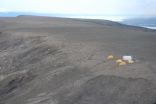(Press-News.org) The old adage "you are what you eat" is helping scientists better understand the threatened loggerhead turtle, which is the primary nester on Central Florida's beaches.
A study published today in the journal PLOS ONE describes how scientists at the University of Central Florida used a technique that links chemical signatures of the turtles' diets and their watery environments to their migratory routes. They found the technique just as effective as expensive satellite tracking.
Little is known about the turtles, which spend 99 percent of their time in the water and return to the Archie Carr National Wildlife Refuge's beach to nest once every two to three years. The 13-mile-long beach is home to the second-largest population of loggerheads in the world and to about one of every four nests those turtles lay in the United States.
While other turtles' nests are increasing along the refuge's shores, the loggerheads' have been declining since 2000. The technique validated by the UCF scientists could help managers preserve the turtles' nesting grounds, migration routes and foraging grounds, all of which are critical to their survival.
"We need good information so policy makers can focus the limited conservation funds available where they can make the greatest impact," said Simona Ceriani, the UCF graduate student who led the study. "We all want our children to see these beautiful creatures and not just read about them in a book."
In addition to validating the tracking technique, the study found that the foraging area for the Florida turtles is much broader than previously thought.
"Think of these turtles as Florida tourists and snowbirds," Ceriani said. "They come and nest and then go back to lots of different places. And while we knew some went back north, we had no idea that this was a popular destination."
Based on her tracking, some turtles head for the water off the shores of Virginia and Delaware while others go to the Bahamas and the Gulf of Mexico. Some stay off the coast of Central Florida's beaches. Previously, scientists believed the majority of the loggerheads headed south.
While there are efforts to protect the turtle nests on the beaches, protecting their foraging grounds is equally important, biologists say. Many turtles die because they accidently get caught in fishing nets or encounter other dangers while out at sea.
The technique Ceriani validated should aid those efforts.
She took small blood samples from turtles at the refuge and completed a chemical analysis, which measured distinct markers known as stable isotopes. She also attached transmitters to the turtles so she could follow them using the more expensive but proven satellite tracking technique. The isotope approach proved to be equally useful, and it is much less expensive.
"By combining isotope research with satellite tracking technology, we are learning exciting information about loggerhead sea turtles," said Daniel R. Evans, a research specialist at the Sea Turtle Conservancy and co-author of the research paper. "This research helps scientists and conservation managers identify key feeding areas for loggerhead turtles and helps direct policy and regulations that protect sea turtles in these specific areas."
Ceriani said she will continue to research the migratory routes by adding more loggerheads to the study.
INFORMATION:
Ceriani earned her bachelor's degree at the University of Milan in Italy and was a research fellow at Florida Atlantic University before joining UCF's PhD program in conservation biology in 2007.
Others who contributed to the study include: UCF Biologist, John Weishampel, James D. Roth from the University of Manitoba in Canada and Llewellyn M. Ehrhart from the Marine Turtle Research Group at UCF.
Several grants from Florida's Sea Turtle Grants Program funded this study. The program gets is funding from the sale of the Florida Sea Turtle License Plate.
Sea turtle monitoring at the Archie Carr National Wildlife Refuge was coordinated through the University of Central Florida Marine Turtle Research Group, with funding from Brevard County, the Florida Fish and Wildlife Conservation Commission, the United States Fish and Wildlife Service and the United States National Marine Fisheries Service.
New turtle tracking technique may aid efforts to save loggerhead
2012-09-21
ELSE PRESS RELEASES FROM THIS DATE:
Solving the stink from sewers
2012-09-21
The rotten egg gas leaking from sewer pipes and costing billions of dollars worldwide in odour control may soon be far less of a problem thanks to new research discussed at the 2012 International Water Association (IWA) conference this week.
Trials with a magic mix of chemicals, called Cloevis, on sewers in the Gold Coast region in Australia stopped 99 per cent of the rotten egg gas or hydrogen sulphide emitted from these pipes.
Lead researcher, Professor Zhiguo Yuan from the University of Queensland, told IWA delegates that one week after dosing for a few hours, in ...
Researchers develop new 'stamping' process to pattern biomolecules at high resolution
2012-09-21
Fabricating precise biomolecular structures at extremely small scales is critical to the progress of nanotechnology and related fields.
Traditionally, one of the ways this has been accomplished has been through the use of rubber stamps with tiny features — similar to those used by children in play, but detailed at the microscopic scale — which are covered with molecular "inks" and then stamped onto substrate surfaces, creating a molecular patterns. But when using this technique at the nanoscale, molecules tend to diffuse on the surface both during and after stamping, ...
Advancing the treatment of trauma
2012-09-21
With traumatic injuries claiming almost six million lives a year, improvements in care, including in the challenging areas of brain and bone injuries, and haemorrhage, are urgently needed.
Leading medical journal The Lancet today published a series led by researchers and clinicians from the National Trauma Research Institute (NTRI), a collaboration between Monash University and Alfred Health, which notes the difficulties and charts the progress in improving three critical areas of trauma care.
Traumatic brain injury (TBI) is the leading cause of trauma-related deaths ...
'Kick-starting' male fertility
2012-09-21
Adding a missing protein to infertile human sperm can 'kick-start' its ability to fertilise an egg and dramatically increase the chances of a successful pregnancy, a team of Cardiff University scientists have uncovered.
The team from Cardiff University's School of Medicine first found that sperm transfers a vital protein, known as PLC-zeta (PLCz), to the egg upon fertilisation. This sperm protein initiates a process called 'egg activation' which sets off all the biological processes necessary for development of an embryo.
Now, the team has found that eggs that don't ...
Nunavut's mysterious ancient life could return by 2100
2012-09-21
This press release is available in French.Global climate change means that recently discovered ancient forests in Canada's extreme north could one day return, according to Alexandre Guertin-Pasquier of the University of Montreal's Department of Geography, who is presenting his findings at the Canadian Paleontology Conference in Toronto today. "According to the data model, climate conditions on Bylot Island will be able to support the kinds of trees we find in the fossilized forest that currently exist there, such as willow, pine and spruce. I've also found evidence of ...
Nudge or think: What works best for our society?
2012-09-21
If approached in the right way, citizens are willing to change their behaviour and do more to help themselves and others, according to research funded by the Economic and Social Research Council (ESRC). The project, carried out jointly at the universities of Manchester and Southampton, experimented with different interventions techniqueswhich encourage citizen participation and explored people's motivations for community involvement.
The researchers focused on comparing the effectiveness of 'nudge' techniques, where people are offered incentives to change their behaviour, ...
Research blog: An expedition to the Earth's fiery heart
2012-09-21
Volcanic activity on and around La Réunion is driven by a localized upwelling of hot buoyant magma. Unlike most magma sources, this is not located on the boundary between two tectonic plates, and rises from much greater depths. It is a so-called hotspot, and has left behind on the overlying mobile crust a track of volcanic activity that stretches 5500 km northwards to the Deccan Plateau in India. Some 65 million years ago, in a process that had a massive impact on world climate, the Deccan area was covered with enormous amounts of lava as the Indian Plate passed over the ...
New challenges for ex-Olympians
2012-09-21
When elite-level athletes retire, they often struggle to adapt to their new lives. When finding that the characteristics that were valuable in sport are not equally useful in 'ordinary' life, they often start experiencing disorientation, depression, self-doubt or even illness. This is concluded in research from the University of Gothenburg.
Successful athletes at the elite level develop characteristics that should generate success also later in life. However, this notion may be wrong, according to the new research.
As part of a study, ex-Olympians from Sweden, Switzerland, ...
23 nuclear power plants are in tsunami risk areas
2012-09-21
The tsunami in Japan in March 2011 unleashed a series of negligence related with the resulting nuclear disaster. A scientific study headed by Spanish researchers has for the first time identified those atomic power plants that are more prone to suffering the effects of a tsunami. In total, 23 plants are in dangerous areas, including Fukushima I, with 74 reactors located in the east and southeast of Asia.
Tsunamis are synonymous with the destruction of cities and homes and since the Japanese coast was devastated in March 2011 we now know that they cause nuclear disaster, ...
Remarkable enzyme points the way to reducing nitric acid use in industry
2012-09-21
An enzyme in the bacterium that causes potato scab could help create new, environmentally-benign biocatalysts with the potential to cut use of the highly corrosive chemical nitric acid.
Chemists at the University of Warwick in the UK, in collaboration with researchers at Cornell University in the USA, have reported in the journal Nature Chemical Biology the discovery of an enzyme in the bacterium Streptomyces scabies that catalyses an aromatic nitration reaction.
TxtE, a cytochrome P450 enzyme, is the first example of an enzyme that has specifically evolved to catalyse ...

